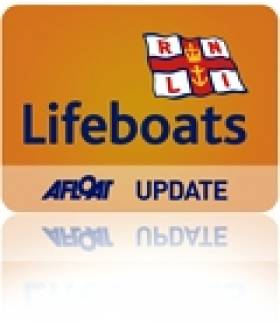Displaying items by tag: Strangford Lough
Strangford Lough Sailing Secrets Revealed
#strangfordlough – Strangford Lough is one of Ireland's most important sailing locations, yet it is surprising how few sailors from other areas have savoured its unique attractions. W M Nixon tries to explain why this is so, and delves into the racing enjoyed this week by two very different classes of boats on an alluring and secret water.
Strangford Lough is a very private and hidden sort of place, whether by sea or land. Prehistoric voyagers through the Irish Sea will only have guessed and wondered at the possible existence nearby of this huge salt water lake if they happened to be near the approaches to the narrow entrance during the six hours in twelve when the ebb flows, pouring out of the lough with such vigour that the turbulence can push two or three miles out to sea. And on land, even with today's road system much of Strangford Lough remains hidden from sight.
For sure, you can have fine clear views if you happen to be driving along the road on the lough's eastern shore between Newtownwards and Kircubbin, seeing clear across the water to the lough's islands and rolling coastal hills, and beyond towards the purple peaks of the Mountains of Mourne.
But those vistas only flatter to deceive. The most intricate interaction between sea and land is largely unseen. This is along the lough's western shore, where the drumlin country which defines much of County Down becomes a remarkable pattern of sea and islands. Very occasional glimpses of the sea – inevitably with some boats moored on it in a sheltered and private looking spot – is all that the curious sightseer on land will get for his trouble.
This continually surprising if occasionally frustrating inlet is 15 nautical miles long by six miles wide. The Narrows, which feed it twice daily with a huge surge of tide from the Irish Sea, are 8 miles in length, but less than half a mile wide at their most constricted section at Bankmore Point, where the streams can run at better than eight knots and the neighbourhood whirlpool, forming just when you're thinking it doesn't really exist, is called the Routen Wheel.
While the similarly swift tides which flow through the entrance of the Morbihan in southern Brittany can become something of a small boat playground in summer, Strangford Narrows has a more serious image as the overfalls on the ebb to seaward are a much more challenging proposition. Nevertheless it's fun to sail much of it on the fair tide, and in going into the lough with the tide under you, even in ancient craft you find you're beating at better than ten knots over the ground, the VMG is jet propelled, and soon you're swooshed into a miniature cruising paradise with a myriad of islands – 365 of course - and a wide range of overnight options.
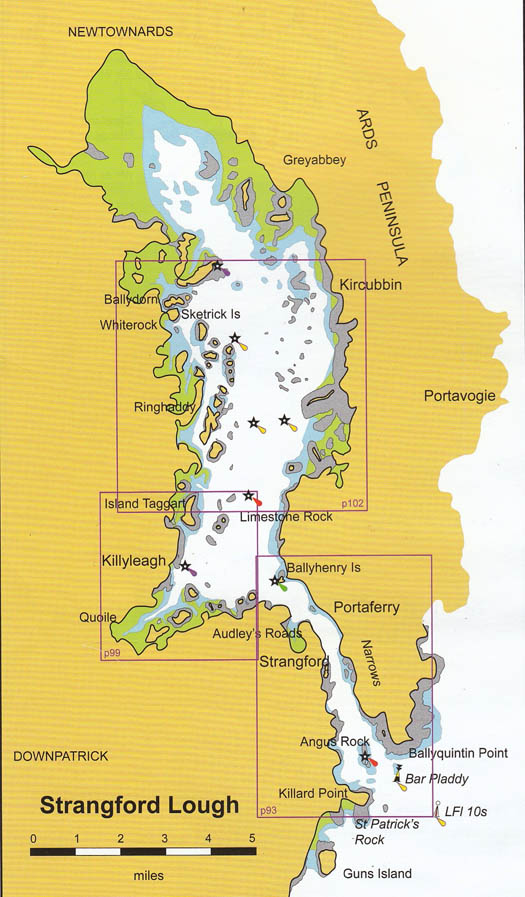
The secret place – despite its substantial size, Strangford Lough remains a mystery to a surprisingly large number of sailors. Courtesy Irish Cruising Club

Strangford Lough's western shore provides tantalising glimpses of sea and islands, usually with boats moored in a snug spot. Photo: W M Nixon
But even when you arrive at the lough by this much-preferred option of being on a boat, there's still that slight sense of intruding on a private place. While Portaferry on the east side of the narrows may present a traditional welcoming façade, and Strangford village to the west is its own charming little self, of the other towns on the lough only Kircubbin halfway up the eastern shore has anything vaguely resembling a waterfront. The lough's biggest township, Killyleagh on the west shore, may have a modern recently-developed waterfront. But that's a private enterprise thing, the town's main street is at some remove from the shore, while other urban centres in the Strangford Lough area such as Downpatrick, Killinchy, Comber, Newtownards and Greyabbey may be near the sea, but they're not of it.
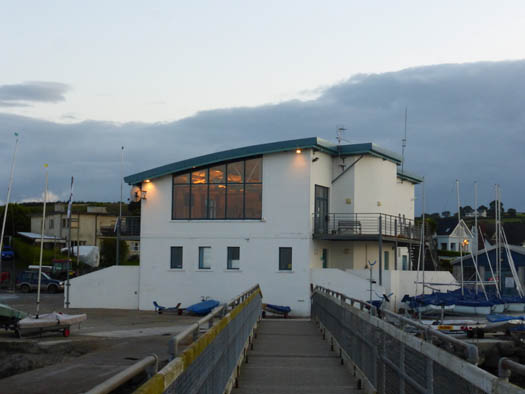
The lough's premier club is the Strangford Lough YC at Whiterock, where this "new" building has been serving members' needs for a dozen years now. Photo: W M Nixon

The view from within. Though the SLYC building may present a utilitarian appearance, its main room is successfully multi-purpose as lounge, dining room and bar, and the view from it is of a comfortable anchorage ready for sailing. Photo: W M Nixon
Yet the lough is home to hundreds of boats, serviced both by private facilities and something like eleven different boat, yacht and sailing clubs. But most of them are along that complex western shore where, in choice locations, the big landowners who had made their money in Belfast's boom days from 1850 to 1912 were so keen to preserve their privacy that they made sure there were no road signs on the few narrow public roads approaching their substantial houses near the shore.
Some years ago, there was an official attempt to liberalise this with a sprinkling of signs, but a visit this week showed that many of them had somehow disappeared, or become invisible under the verdant growth which is fundamental to this heart of the County Down. So more than a smidgin of local knowledge is needed if you wish to access the sailing in this maritime wonderland. But if you can do so, the sport is wonderful if racing around islands and in wayward yet manageable currents is your thing, while there's enough open space in mid-lough to provide a clear venue for major open events, even if it can involved a bit of a sea trek from the shore base at some hidden club.
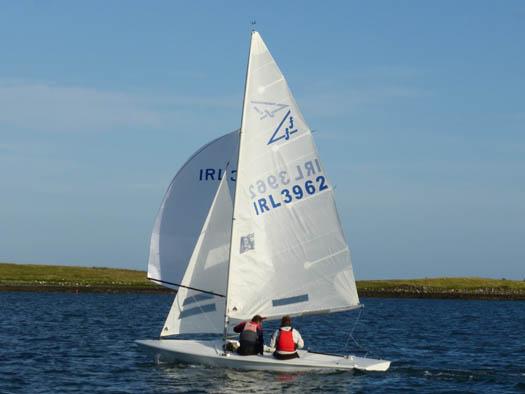
A Flying Fifteen in action at Whiterock off Strangford Lough YC, which has produced F/F Champions to world level.
The active sailing scene in Strangford Lough has produced champions to world level over the years, most notably in the Flying Fifteen class where Strangford Lough sailing surnames such as Carson, Brown, Andrews and McCann have been inscribed on the top trophies down the decades. Thus there's a sense of history in the making with this year's Irish F/F Championship being staged in six days time from August 22nd to 24th by Portaferry Sailing Club at the southeast corner of the lough, where it will be interesting to see how far north they have to go in order to get clear of the fierce tides which flow close past the club's headquarters near Portaferry Marina beside The Narrows.
Meanwhile, this week we'd the chance on Strangford Lough to suss out the racing in two classes which may seem very different, yet each emerged from a clearcut initial requirement which now seems very remote.
The River Class boats at the lough's premier club, Strangford Lough YC at Whiterock on the west shore near Killinchy, really are the area's best kept secret. This is quite an achievement in an ultra-private place like Strangford Lough. Everyone involved with the Rivers knows so much about them that they assume the rest of the world does too. But surprisingly few outsiders know that in the inner reaches of Strangford Lough, they race a class of handsome Alfred Mylne-designed 29ft one design sloops which yield to no-one for classic good looks.
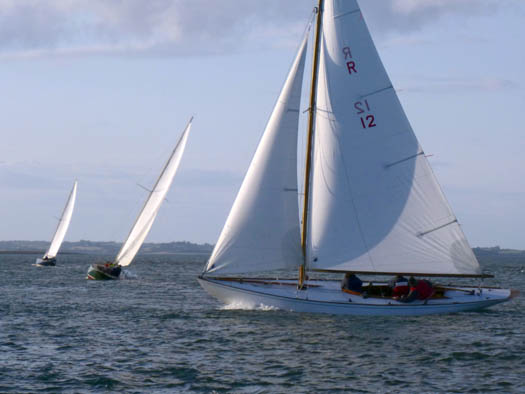
The Mylne-designed 29ft River Class combine classic good looks with real sailing power. Photo: W M Nixon
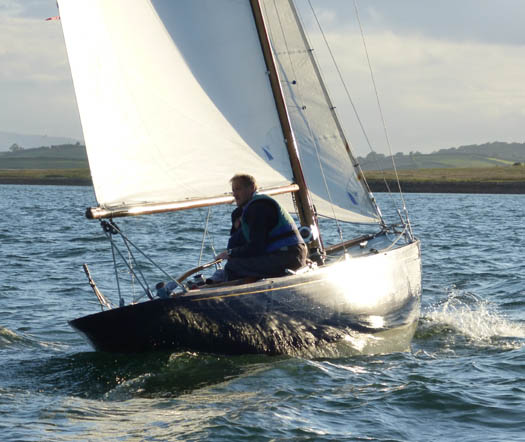
As usual, River Class champion Kenny Smyth has to look astern to see how the opposition is doing. Photo: W M Nixon
Their origins date back to 1919, when some northern sailing people started exchanging ideas about the need for an easily-handled simple sloop "which could be sailed by a man and his daughters". At first glance, this seems like a welcome and liberal requirement, fuelled by the emergence of the suffragette movement seeking votes and rights for women. But in fact, it's the bleakest design spec you ever read. The Great War of 1914-18 had resulted in the deaths of so many young men from the north of Ireland, with scores of them boat enthusiasts who had been active sailors before its outbreak, that the only way the sport could resume in any meaningful way was by moving on from the labour-intensive gaff rigs, jackyard topsails and multiple headsails of the pre war days, on into a simple rig which faced the harsh new reality.
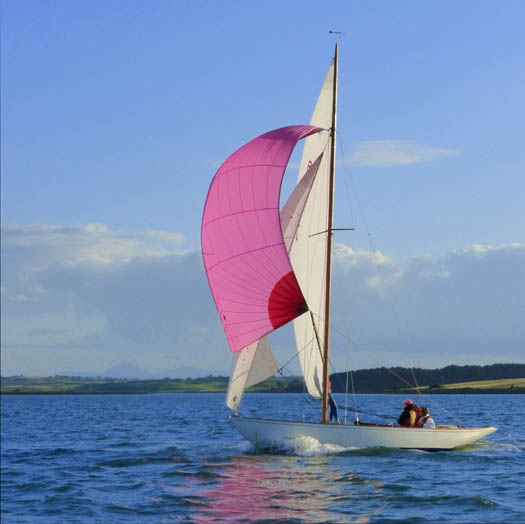
The essence of Strangford Lough – a River Class sloop sailing well, and the timeless view beyond across County Down to the Mountains of Mourne. Photo: W M Nixon

If dodging tides by going close inshore is your thing while using every little twist to the wind, then racing Rivers on Strangford Lough is just for you. Photo: W M Nixon
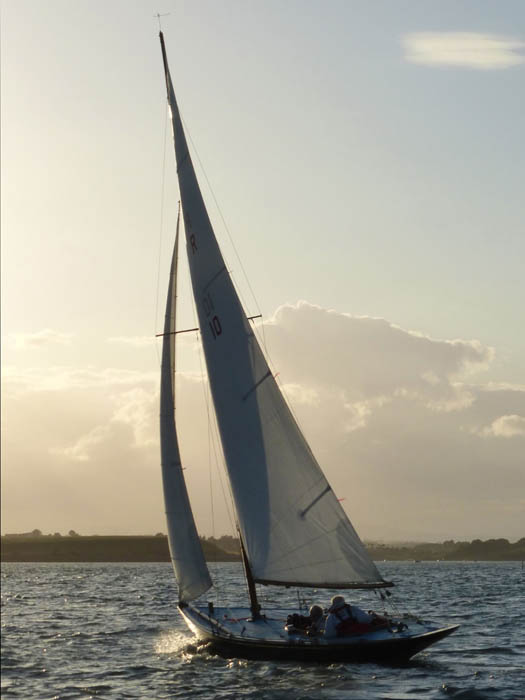
In harmony with her surroundings, a River Class sloop makes her elegant way afloat. Photo: W M Nixon
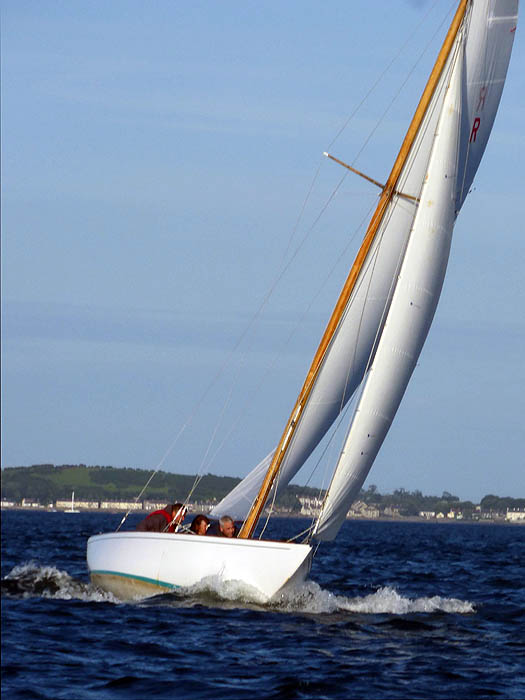
When there's a bit of bite to the breeze, it's impressive how much power the conservatively-canvassed River Class sloops can develop. Photo: W M Nixon
But though the rig may have spoken volumes – it's believed to be the first Bermudan-rigged one design – there was no way that the great Alfred Mylne, the man who reputedly drew the lines of Britannia in 1892-93 as a trainee naval architect in G L Watson's Glasgow office, was going to design anything other than a good-looking boat. Admittedy, with her cockpit well aft, there can be times when a River seems to sit on her stern if her crew are more interested in comfort than boat trim. But when she's sailing on her designed lines, she's a joy to behold, and with her heavy but harmonious hull, she can carry her way in impressive style, making tacking a nicely judged and elegant manoeuvre if it's done right.
In all, a dozen Rivers have been built, most of them before 1923, while the class started racing in 1921. At first, they shifted their racing venues between Belfast Lough and Strangford Lough, as the owners were mostly members of Royal Ulster YC at Bangor. But from time to time they liked to moor their boats off their shoreside big houses on Strangford Lough, usually with their estate gardeners being roped in for additional duties as boat delivery crews sailing between the two loughs along the often rough North Channel coast of the Ards Peninsula. The very thought of it might easily turn anyone into a firebrand revolutionary.
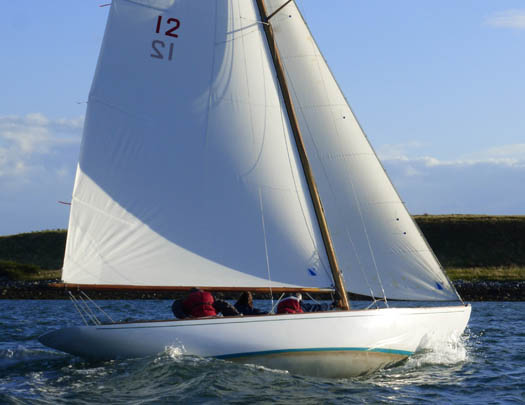
The River was designed by Alfred Mylne in 1920, and shows some family resemblance to the Mylne-designed Dublin Bay 21s (1902) and Dublin Bay 24s (1937), while still being very much an individual in her own right. Photo: W M Nixon
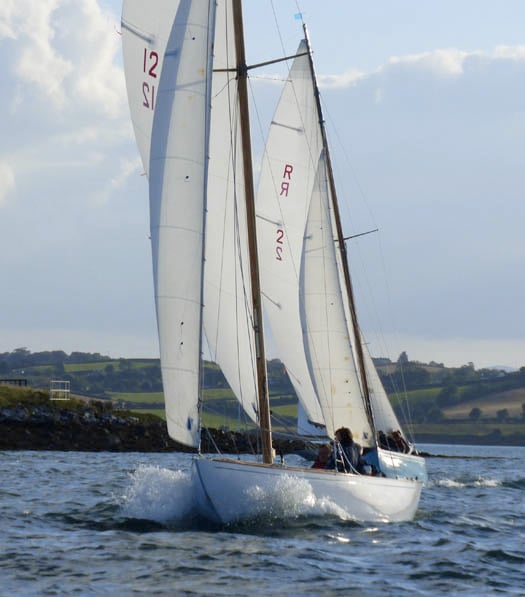
Thanks to an adequately-sized rudder of only moderate rake, it is possible to race the Rivers at close quarters with confidence. Photo: W M Nixon
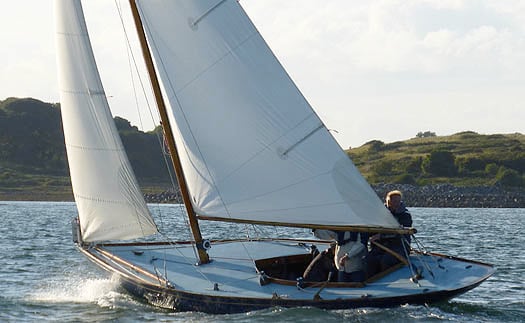
As the Rivers don't set genoas, the correct trim of the little jib is absolutely key to racing success. The class has strict rules about replacing sails only as a group in order to maintain one design performance. Photo: W M Nixon
Be that as it may, gradually the focus moved completely to Strangford Lough, and for a while the class had such a preponderance of aristocratic owners that you could be forgiven for thinking it was P G Wodehouse's take on yachting. Typical were Lord and Lady Londonderry (they pronounced its London-dree), with their seat at Mount Stewart on the lough's eastern shore.
They argued so much aboard their River that they had to get another one so that Lady Edith could race against her husband. In the late 1930s, when she began to favour a policy of Appeasement with the resurgent Germany and flirted with Hitler's Nazis, she invited the Nazi big cheese von Ribbentrop to stay at Mount Stewart and sail with her in a race off the house aboard her River, which was duly T-boned during the event by her husband in his boat.
That was about the height of international excitement and celebrity for the Rivers. By the end of the 1930s, the class had become based at Whiterock with the new Strangford Lough Yacht Club, and the only time they subsequently emerged blinking into the outside world was in 1951 when they sailed as a group to race in the Festival of Britain Regatta Week on Belfast Lough, where the supreme champion by a mile in the River racing was the young Barry Bramwell sailing his family's boat Roe. His subsequent stellar sailing career included winning many dinghy championships, and he skippered a boat for Ireland in the Admiral's Cup.

Although the River Class have not sailed outside Strangford Lough since 1951, their close competition at home has produced some notable performers in other boat types. Photo: W M Nixon
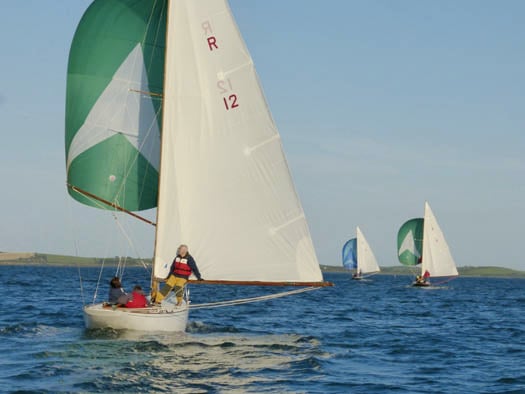
Rivers on the run, and looking very handsome with it. The class has decided that having a kicking strap would not be in the spirit of the design, so having a crewman seated on the boom on a dead run is standard practice. Photo: W M Nixon

With the crew up forward under the deck, and only the helmsman aft in the cockpit, Brian Law's Uladh (10) is perfectly trimmed for best performance to windward. Photo: W M Nixon
The Rivers meanwhile returned home after the Festival Regatta Week, and since 1951 the nearest they've ever got to the open sea is the annual visit to the time-honoured Narrows Regatta between Portaferry and Strangford for a few days in July. Otherwise, they might sometimes be seen at local regattas at the Quoile, Killyleagh and Kircubbin. But for the most part, they stay in stately seclusion at Whiterock and enjoy a compact annual racing programme. This may seem to be only relatively few races to those from other hyper-keen local one design classes. But after 93 years, the Rivers have become such an integral part of the fabric of sailing at Whiterock, and such a central part of community and family life for those involved, that you don't need a huge number of races for each season to be a success, what's needed is the savouring of the moments afloat on a summer's evening, and then an analysis of each race in loving detail in the friendly clubhouse afterwards.
With the GP 14 Worlds coming up on Strangford Lough this past week, there was an ideal opportunity to contrast two forms of sailing there. I'd already tried to get some River Class photos on an evening earlier in the season by signing up to sail as fifth hand aboard Brian Law's Uladh (the von Ribbentrop boat). But when we all assembled, it emerged - in typically Strangford Lough style - that the helmsman was delayed by the need to get his wife and daughter's vintage horsebox through its MOT test, so I was stuck on the Tiller That Von Ribbentrop Held.
Despite that, the boat was a joy to sail in a light summery shirt sleeves breeze, but it resulted in damn all worthwhile photos on the disk. So this week, Brian and another River owner Kenny Smyth, Vice Commodore SLYC, arranged for Chris Boston, whose hobby is being a sort of Honorary Boatman at Whiterock, to take me out to buzz around the racing fleet on an August evening with a decent though fading northwest breeze, and Chris did a super job.
My camera is just a clever little Lumix, which is a Leica lens with a sort of digital Box Brownie stuck on the back. So please excuse the fuzzy telephoto shots, but the photos speak for themselves – the Rivers are good looking classic boats which provide great sport. These days, the Smyth brothers Kenny and Graham are setting the pace, which suggests sailing enthusiasm of a high order. Their day job is running the characterful little boatyard immediately south of Whiterock, an establishment created by their legendary father Billy who introduced his family to cruising through extensive ventures in the former Manx fishing boat Aigh Vie (see this blog on 29th March 2014). Whatever way Billy Smyth did it, he imbued his sons with such enthusiasm that they can spend their working day being busy fixing somebody else's boat, then go out and sail their own boats with equal dedication in the weekly evening race. And they're more than generous with helpful tips to their opponents on tactics and tuning.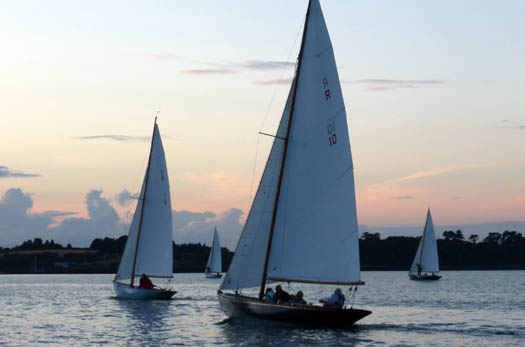
When they talk of "twilight racing" in the River Class, they really mean it......Photo: W M Nixon
Having spent an entertaing and very complete evening with the classics that were designed so that they could be sailed by a man and his daughters, next morning found me contemplating a hundred dinghies to a 14ft design which was originally envisaged as a useful and versatile little boat to provide "affordable fun afloat for Pa, Ma and the kids".
Like the River, the GP 14 emerged in a post war situation, but in 1949 the mood after World War II (1939-45) was much more egalitarian than it had been in 1919. The General Purpose 14 was the brainchild of Teddy Haylock, the Editor of Yachting World magazine in London, and it was one of the first in a series which became the YW Build Her Yourself boats, mostly designed by Jack Holt with DIY plywood kits supplied by Bell Woodworking Co.
Haylock still carried his wartime title of Group Captain E F Haylock after a "good war" with the RAF, but he had a very clearcut view of how things should go in peacetime. If his projects sometimes seemed to be delivered in a slightly patronising tone, there's no doubt his heart was in the right place, even if some of his posher advertisers weren't at all pleased by his glossy magazine devoting so much energy to people who hoped to self-assemble their own boats rather than buy a complete and expensive one from an established yacht builder.
To say that the GP 14 succeeded beyond anyone's wildest dreams is under-stating the case. Though the 14,000-plus boats built worldwide have been used for general purposes, they're primarily racing boats these days, and it was this which brought a hundred of them to the well hidden East Down YC in behind Island Taggart on Strangford Lough's west shore just north of Killyleagh.
Back in 1970, most folk thought that just about every possible sailing club site on the shores of Strangford Lough had been earmarked and developed. But the founders of EDYC discovered this place, which was accessible by land only along a narrow unpaved track going so close to the edge of a farmyard that it almost goes through it. In those days before 4X4s were ubiquitous, you really did need a Landrover to get to the new waterfront location with any certainty. But over the years the club has expanded its clubhouse and its facilities ashore with an extensive dinghy park, while the keelboat fleet linked to the club includes former Commodore Jay Colville's First 40 which took part in this year's ICRA Nats in Dun Laoghaire.
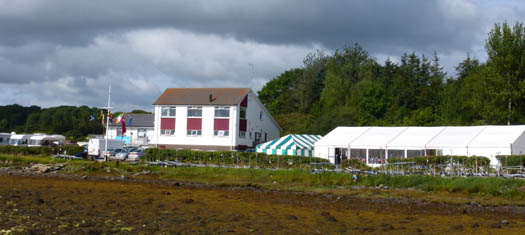
East Down YC, venue for the GP 14 Worlds 2014. Photo: W M Nixon

Somehow or other, the founders of EDYC in 1970 managed to shoehorn their substantial clubhouse with its large dinghy park into a previously unused waterfront setting accessed via this narrow lane. Photo: W M Nixon
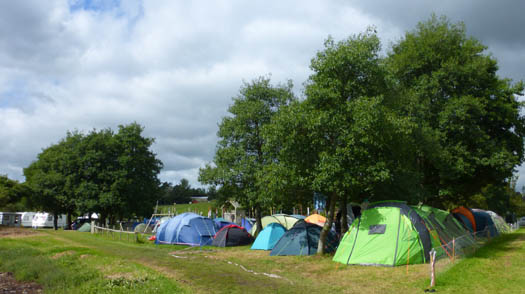
All that GP 14 sailors require is somewhere to pitch their tent........Photo: W M Nixon
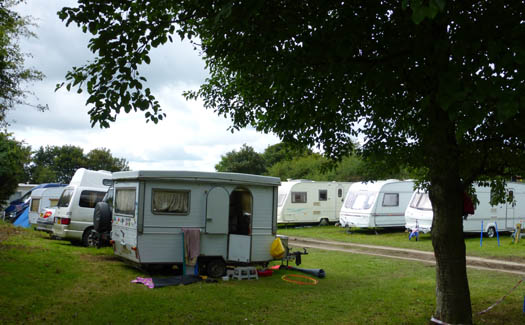
...or park their 'van. Photo: W M Nixon

Graham Wright of EDYC gallantly took on the challenge of chairing the Organising Committee for the GP 14 Worlds 2014 with just two years to go to the off. Photo: W M Nixon

The kind of headlines that any organisers dread. Yet EDYC were quite rightly so confident about their proper handling of the weather problems that they subsequently displayed this newspaper spread in the main marque. Photo: W M Nixon
Taking on a Worlds is a formidable challenge for any club, and when it's the Worlds of a dinghy class which is as important in Ireland as the GP 14, the pressure is greater still. It was as recently as 2012 that East Down was approached by the Irish GP 14 Association as they realised other avenues were being closed off in their search for a willing club for their allocated staging of the Worlds in 2014, and the club deserves an award for courage in taking it on, setting up an Organising Committee under Graham Wright and getting the show on the road.
I'd a telling instance of just why the GP 14 is so relevant recently while heading through Youghal, where three dinghy masts were visible above a harbourside wall. On the other side of the wall was one of those little mud-filled docks which are such a feature of Youghal's waterfront, and sitting serenely on the mud were three GP 14s.
What else could they have been? As I was to discover at EDYC, the GP 14 is central to building up the sailing club at Youghal, and at many other clubs all round the country too. While some members may try more glamorous boats from time to time, the GP 14 ticks most boxes in terms of versatility while setting a spinnaker, having an effective class structure, and providing racing at all levels.
My own links to the class go back to the 1960s when the sailing club at Queens University in Belfast suddenly found itself supplied with funds for a new boat or two provided the boats were built within a specified time. Although club captain, I was already a dedicated keelboat man except for the annual foray into Fireflies racing against other colleges in Dun Laoghaire and England & Wales. In other words, I knew nothing. However, our Honorary Secretary Mike Balmforth was a very switched on guy who had built his own Enterprise with his father. But as QUB already had a couple of old GP 14s, he soon decided that we could get the boats built on time – and they'd be GP 14s as required - by a relative newcomer to boatbuilding called Gerry Duffin, a former housebuilder and carpenter who had his workshop in East Belfast and was starting to fulfil his dream of building boats.
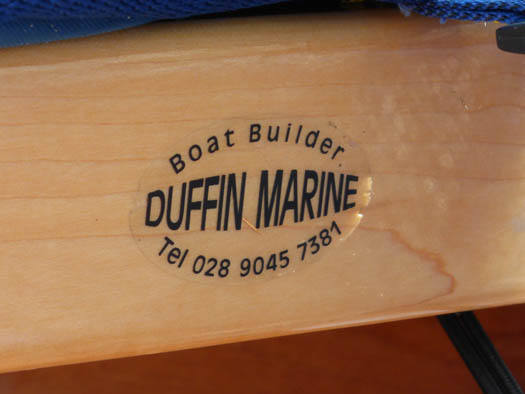
The sign of success – the home firm builds the best GP 14s in the world. Photo: W M Nixon
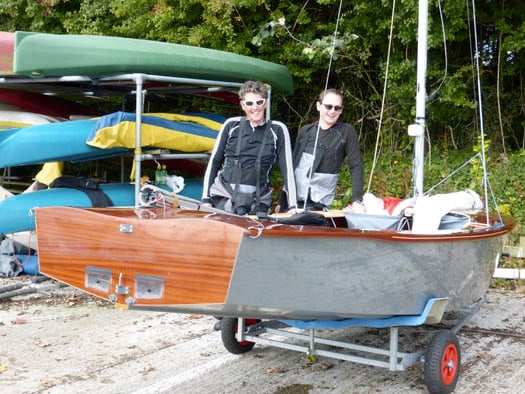
The "Duffin dip" in the transom of the newest boat for the Lough Foyle fleet. Photo: W M Nixon
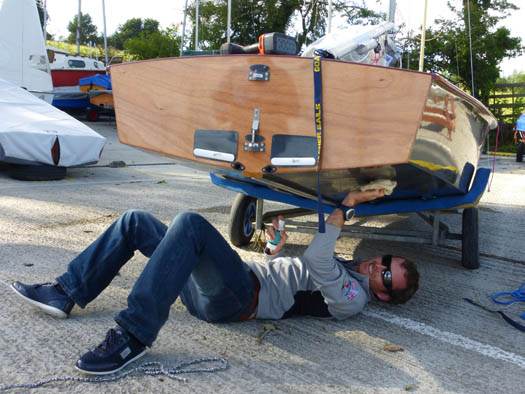
"If you want to be sure it's done properly, then you have to do it yourself" Top contender Ian Dobson putting in some work on the hull finish. Photo: W M Nixon
One rainy day we went across town in Mike's rickety Austin 7 (its wooden frame was supported by Spanish windlasses utilising electric cable instead of rope), and there in the shed was the first of the new boats. It was a very old shed, and there were several leaks which prompted Gerry to quip that he really should get the builders in. But to our young eyes, there was nothing to see but this lovely new GP 14, an early product of a line which continues to the present day, for at East Down YC this week all the main contenders, and indeed the majority of the fleet, were Duffin built, with Duffin Marine for many years now being run by Gerry's son Alistair.
Like the Smyth brothers up at Whiterock, his enthusiasm is almost certifiable, as he not only builds the best GP 14s for everyone else, but he also races keenly with the class. And though the rules are strict, he is always trying to find ways of innovating his products, which are more like collector's furniture than boats.
In recent years, he has tried to persuade the class to let him take out most of the transom in modern style, but when an open transom was declared verboten, instead he introduced the "Duffin dip" in the afterdeck. When asked why, his answer was that he just keeps trying to reduce weight. Whatever, people certainly love his boats. I was at East Down briefly in late afternoon on the layday on Wednesday, and though there were few folk around, down at the end of the dinghy park was top contender Ian Southworth beavering away at his beloved Duffin boat.
The mood was distinctly relaxed with the club and the class well recovered from he unexpected wall-to-wall attention they'd received on the Monday. A couple of nasty squalls – yet another by-product of the slow progress of former Hurricane Bertha across northwest Europe – had resulted in between ten and twenty boats having some difficulty in coping with being capsized. But the Championship safety team were handling it competently when it was declared an Emergency Situation by some Powers That Be. Almost immediately those narrow roads and single track approaches to the club were jammed with ambulances and a fire brigade as helicopters gyrated overhead.
While some newspapers sought only to have shock headlines, it has to be said that when the scale of the over-response became evident, it was heartening to see how the better strands of the media responded to it all with an intelligent and friendly interest in what was going on. They were fascinated by how an event which was classed as a World Championship was being staged, and staged so effectively too, at the end of a tree-lined single-track lane in remotely rural County Down. In the end, the clear egalitarian nature of GP 14 racing and the calmness of the people involved reflected very well on the image of our sport. And as for the multiple rescue and emergency services, they had all the benefits of a "for real" exercise which might prove to be very useful in the unlikely event of a passenger jetliner ever coming down among the islands of Strangford Lough.
The atmosphere may have been serene in the late afternoon of the layday, but next morning with three races scheduled in a brisk nor'wester, the club compound was hectic enough for anyone. And the layday did the trick – as one of the International Jury remarked, it is very unusual at any Worlds to see the entire fleet put to sea two thirds of the way into the event, but they poured down the slip and away out round the island, and at the end of it there wasn't a boat left ashore.
But by that time I'd had every opportunity to observe the spirit of the GP 14s, and it is formidable. Ireland has a great record in the class, with Bill Whisker of Ballyholme becoming a World Champion, while others like Paul Rowan of East Antrim and Pat Murphy of Clontarf were in the international frame for years.
Yet these days the class is as keen as ever in encouraging new blood and establishing a firm foothold at new clubs. That glimpse of a nascent GP 14 class at Youghal well illustrated the point, and it was Norman Lee who told the story. I'd spotted the famous vintage camper van which is the campaign base for GP 14 legend Norman Lee of Greystones, who is crewed by his brother Ken and supported by Norman's wife Una and their two collie dogs - dogs on campaign are very much a GP 14 thing.
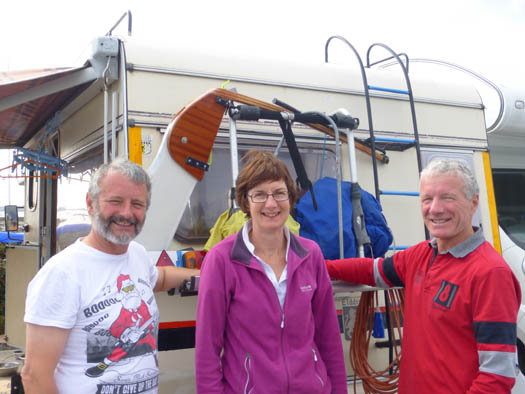
The Lee team from Greystones with their vintage campervan are Ken (left), Norman (right) and Una. Photo: W M Nixon
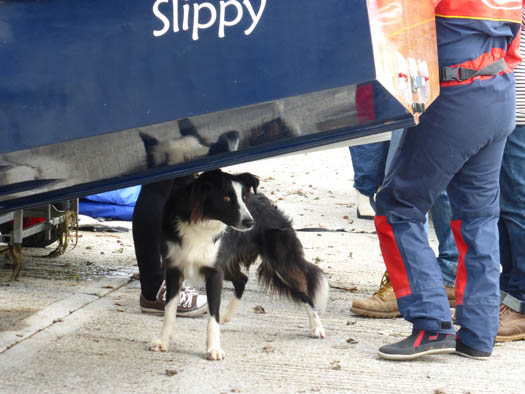
If you're going to have a GP 14.........Photo: W M Nixon
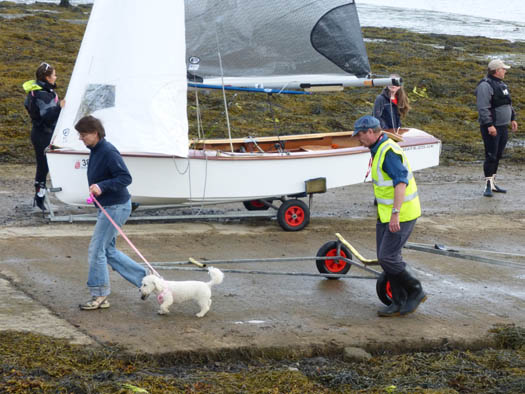
....then you have to have a pooch. Photo: W M Nixon

...and while most breeds are allowed, a collie variant is preferred. Photo: W M Nixon
The Lee equipage was in fine form, having taken a useful second in one of Tuesday's races, but as soon as I mentioned the presence of the Geeps at Youghal, all that was forgotten as Norman enthused about the growing club there, and what he and the class are doing to get Youghal's GP fan Adrian Lee (no relation) and his group further down the road.
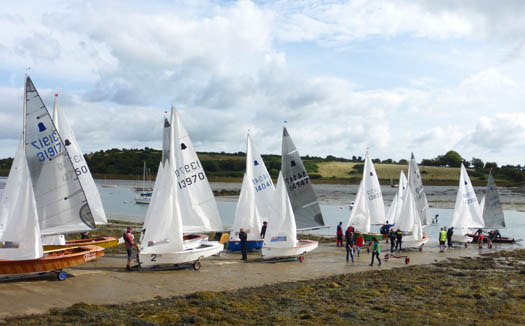
Getting a hunded boats away is a formidable challenge..... Photo: W M Nixon
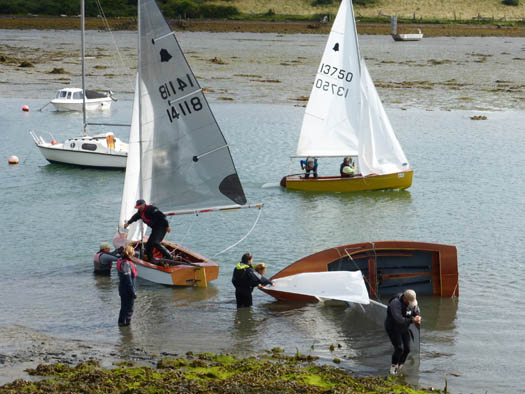
....and the last thing you need is somebody deciding last minute adjustments are essential.......Photo: W M Nixon

....when they're still joining the queue at the top of slip. Photo: W M Nixon
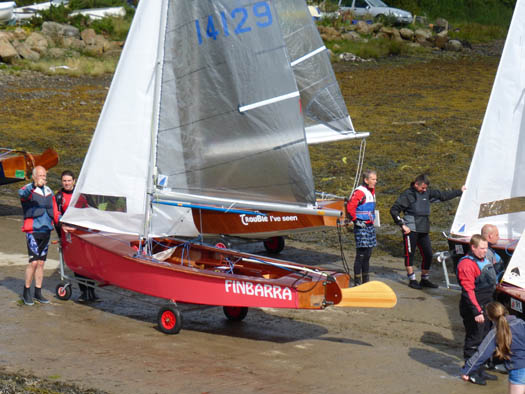
"Don't these guys holding us up realise that they're delaying a whole line of renowned international athletes.....?" Photo: W M Nixon
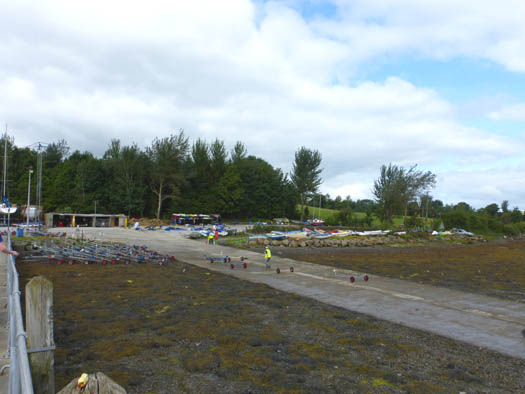
Suddenly, they're gone – every last one of them. This is one very keen class. Photo: W M Nixon
Or more accurately, further up the river. Norman and other GP 14 sailors are fascinated by the possibilities of the mighty Blackwater River which reaches the sea at Youghal. Already, they have had a trial distance sail from the estuary right up to Cappoquin, and this has fired them up so much that they're going to make it a major event when they repeat it in the last weekend of August in order to give Youghal SC a proper re-launch. Their enthusiasm has so fired up others that top GP 14 racers like Ger Owens from Dun Laoghaire have said they'll go, as have crews from the growing fleets on Lough Foyle, which is wellnigh as far as it's possible to be from Youghal without leaving Ireland.
It may all seem a bit far-fetched. But believe me, when you're in a large dinghy park at the end of a small farm track in the depths of County Down, and when the event photographer has just gone aloft in a small aircraft because that's the best way to get snaps of a major dinghy event out in the middle of Strangford Lough, then long distance dinghy sailing events from Youghal to Cappoquin seem eminently feasible.
#coastguard – The Coastguard is this afternoon coordinating a rescue response after approximately 100 sailing dinghies at the GP14 world championships hosted by East Down Yacht Club were hit by stormy weather on Strangford Lough. A major incident has been declared.
Belfast Coastguard was first contacted just before 2pm reporting that some of the boats had capsized, while others were struggling to cope in the strong winds and squally showers.
The Bangor and Portaferry Coastguard Rescue Teams, the Portaferry and Newcastle RNLI lifeboats, the Irish Coast Guard helicopter along with the helicopter from RAF Valley have been sent to the scene.
It is not clear at this time how many people are involved and if there are any injuries. A search and rescue operation is ongoing.
Further update as we have it
#strangfordlough – On the 11th to 14th July one of the best four days sailing in Ireland takes place in the hidden gem that is Srangford Lough in Co. Down writes Philip Sandford. The 'Narrows Series' is comprised of four separate races for all classes of Boats large and small. On the evening of Friday the 11th July the series kicks off with the eagerly anticipated 'Bar Buoy' race run by Strangford Sailing Club. This race has a start line running between the lovely sea front towns of Strangford and Portaferry sitting on opposing sides of the Narrows that empty and fill Irelands largest inland sea lough. On the last of the ebbing tide up to 100 boats race out of the lough over the 'Bar' and in to the Irish Sea. They soon turn and return on the flood tide. This is followed by the now infamous late night festivities hosted by Strangford Sailing Club which nestles in the lovely setting of the National Trust property at Castleward.
The following three days then see Strangford Sailing Clubs regatta followed by Portaferry Sailing Clubs and Portaferry Town committees Regattas. These three days of racing again start close to Portaferry with the racing courses all within Strangford Lough. All four races cater for all classes whether large boat handicap to the vivacious Flying Fifteens right down to juniors in their Optimists.
So if you want keen racing in one of the loveliest settings in Ireland with craic to match, look no further.
#RNLI - Portaferry RNLI's volunteer lifeboat crew were involved in the rescue of 23 canoeists who got into difficulty just off Castle Island in Strangford Lough yesterday afternoon (Saturday 17 May).
The call for help was received at 2.40pm and the volunteer lifeboat crew launched at 2.45pm.
They arrived at the scene just off Castle Island in Strangford Lough in Co Down 10 minutes later, finding six of the party of canoeists in the water.
Weather conditions at the time were cloudy with good visibility, with a slight sea swell and a Force 4 southerly wind.
The RNLI crew recovered two of the people from the water, while a small motor boat which had also come to the canoeists' aid took the other four on board.
The RNLI lifeboat crew then took their two casualties along with two canoes back to nearby Strangford Lough Yacht Club, where the casualties were put ashore into the care of HM Coastguard.
- lifeboat crew then returned to the scene near Castle Island and from there escorted the remaining 17 members of the canoe party back to the safety of the yacht club.
Commenting on the rescue, Portaferry RNLI lifeboat operations manager Brian Bailie said: "Thankfully everyone was brought safely to shore and it is testament to the training and dedication of the volunteer RNLI crew that a potentially tragic situation was averted.
"Strangford Lough is an extremely popular location for groups of canoeists and it is vital that they take all necessary precautions when taking to the water."
Canadian Canoes Swamped Crossing Strangford Lough
#canoe – An overnight trip to Salt Island ended prematurely when five Canadian canoes were swamped by waves as they crossed Strangford Lough in Northern Ireland.
At just after 12 noon a member of the public called 999 to report that two kayaks were in difficulty north of Green Island and there were people in the water. Belfast Maritime Rescue Coordination Centre sent the Coastguard Rescue Teams based in Portaferry and Bangor to the Lough with the RNLI Lifeboat based in Portaferry. Dive Rhib Nemo also joined the rescue.
Seven canoeists from a party of 14 were pulled from the water. All 4 adults and 10 teenagers were taken to the shore by the two boats where they received medical attention.
Jude McNeice Belfast MRCC Watch Manager said:
"The group were equipped with lifejackets and safety helmets but obviously weren't expecting to spend time in the cold water.
"Although the sun is shining the wind is blowing and so conditions on the Lough are quote rough. I'd just like to take this opportunity to remind anyone planning to enjoy the spring weather to check weather forecasts and tidal conditions before you set out."
RNLI add:
The call for help was made at 12.05pm and the lifeboat was launched four minutes later. Arriving on scene the lifeboat crew immediately went to the aid of the four kayakers in the water. They recovered them onto the lifeboat and also took a further nine onboard from their kayaks. The remaining group had tied their kayaks together to prevent them from drifting further. The group was made up of three adults and eleven teenagers.
One of the adults stayed with the kayaks while the lifeboat crew returned with the rescued group to Killyleagh pier. They were met by a waiting ambulance, which had been requested when it was learned there were casualties in the water.
Commenting on the callout Portaferry RNLI Lifeboat Operations Manager Brian Bailie said, "This was a very successful rescue for the lifeboat crew who arrived on scene minutes after the alarm was raised. To take such a large number of casualties to safety is a testament to their training and skill. We are delighted that everyone is safe and well.
'The group were all wearing floatation devices and helmets. The priority of the volunteer lifeboat crew from the outset was to take the four people from the water first and get them warm. Conditions were fresh with a strong wind blowing across the lough and the group could have quickly been blown in different directions."
When the lifeboat crew had safety landed the casualties on the pier, one of the crew stayed with the group while the remaining lifeboat crew went out to recover the kayaks.
Irish Cruising – Sailing's Magic Elixir for a Long Life
#cruising – Cruising is the hidden side of sailing, yet it's the choice for the majority of those going afloat. Whether it's day cruising, a longer venture in the annual holidays, or the dream cruise of a lifetime across oceans, this is our sport. Unlike racing, which generates its own narrative even if only through the recorded results, much of cruising would slip under the radar completely were it not for cruising awards. W M Nixon considers the latest annual batch from the Irish Cruising Club.
Cruising under sail seems to be the secret of eternal youth. Last night's Annual General Meeting of the Irish Cruising Club in Dun Laoghaire saw a distribution of awards to voyagers from all parts of Ireland who sailed successfully in many areas of the globe in boats mostly of modest size. Yet any outside analyst would soon have made the point that many of the achievers were of mature – sometimes very mature - years, and fulfilling a retirement dream.
But despite any ICC membership gathering these days being a sea of silver heads, age is the last thing they think about. This club of 550 members has become the mixture of an Active Retirement Association – very active indeed, as it happens – and a sort of seagoing extension of the Men's Shed movement.
If you were looking for an illustration of Ireland's changing demographics, and our very rapidly changing attitude as to what constitutes old age, you need look no further than the ICC. Time was when it was thought quite something when one of the club achieved the Golden Jubilee of their membership. But these days, it's no big deal to have been on the strength for fifty years, as the senior member is Joe FitzGerald of Crosshaven, who this year marks 70 years in the club, and he is closely followed by Douglas Mellon who joined in 1947 from Howth - he now lives on the Scottish Riviera in Kircudbright.
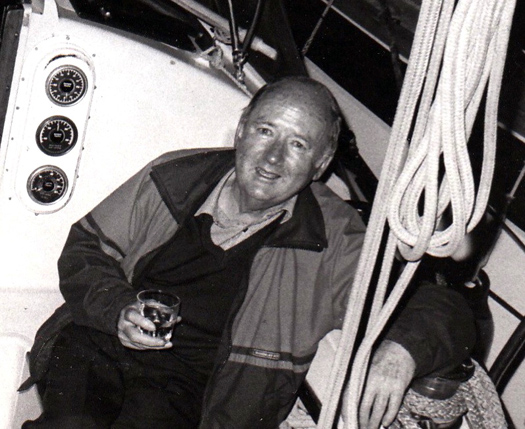
Joe FitzGerald of Cork is the ICC's most senior member, having joined in 1944. He served as Commodore from 1984 to 1987.
All those years ago when they took up their membership, it was thought perfectly normal for young men – married or otherwise - to take off for at least a fortnight's cruising every year, regardless of family demands which these days would be regarded as the prior commitment. In fact, nowadays so much emphasis is placed on family life and families doing just about every last recreational thing together, that younger married sailing people either do extremely short-hop cruising of the type necessitated by catering for the needs of all the members of the family, or else they don't cruise at all in the traditional sense - "Fun For All The Family" effectively rules out proper cruising.
Then too, modern life has so many other distractions - not least of them work demands which involve 24/7 attention - that the old-style easygoing simply-wandering-along holiday cruising is very much a minority activity. This means that at first it seems young people are not taking up traditional cruising at all. But with its deep experience garnered since its foundation in 1929, the Irish Cruising Club has learned to take the long view. It is not unduly concerned by the steadily rising age profile of its membership, and certainly every year there is a significant group of sometimes quite senior yet nevertheless increasingly active cruising enthusiasts joining the club.
They're the embodiment of the slogan that Sailing is a Sport for Life, and it's only politeness which prevents them saying that the subtle pleasures of cruising are wasted on the young. So when you look at the lineup of achievement represented by last night's awards, it's natural to wonder what these people did in earlier life, that they can nowadays afford the time, resources and dedication necessary to complete voyages of this quality.
The adjudication was done by Dave Whitehead of Kinvara on Galway Bay, himself no stranger to the ways of the sea while making long voyages in small craft. He breaks new ground by awarding three trophies at once to Sam Davis of Strangford Lough, whose Cape Horn and Pacific ventures with his Rival 41 Suvretta have been quietly bubbling away in the background of ICC activity for the past three years.
Sam Davis first featured in Afloat magazine in March and April 1981 when we ran his two-part account of his first ocean voyage, an Atlantic circuit from Strangford Lough between 1976 and 1979 with the 34.5ft West Solent Class Suvretta, a former racing boat he'd found in a derelict state and restored to ocean-going condition.

The 34ft West Solent class Suvretta in her offshore racing days in the 1950s when she was based in Belfast Lough. When Sam Davis did the Atlantic Circuit cruise with her in 1976-79, she carried a less loft mainmast, with masthead rig.
But even with Sam's improvements, she was still no more than a slip of a boat, so it says much for his grit and skill that he brought her through the Fastnet storm of 1979 as he sailed the final hundred miles back to Ireland. There was damage aloft, and he'd to get into Dunmore East unaided with jury rigging, but the job was done.
While in the Caribbean, he'd worked in charter yachts between times to make a shilling or two. But after he'd spent time back in Northern Ireland, he went abroad into serious seafaring in offshore service industries, working in places like The Gulf, the North Sea, the Amazon, the Red Sea and Malaysia, becoming a fully accredited Marine Consultant.
Yet if you ask him nowadays what he is and what he was, he'll say he's a farmer and former seaman, as his purchase some years ago of Conly Island in Strangford Lough (you can drive out to it when the tide is down) gives him the little bit of land, and an anchorage too, while "seaman" covers his many experiences in offshore work.
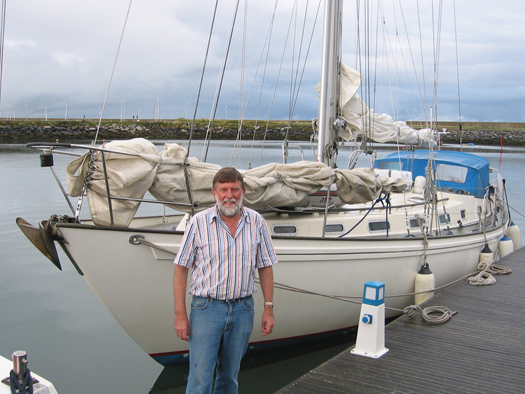
Sam Davis with his newly-acquired Rival 41, re-named Suvretta, in 2009. Photo: W M Nixon

Suvretta in the Beagle Channel in southern Chile. Photo: Sam Davis
Back in 2009 he bought a Rival 41, a hefty and able vessel, a sister-ship of Waxwing in which fellow ICC members Peter and Susan Gray of Dun Laoghaire went round the world 14 years ago. Sam re-named his new boat Suvretta, spent the winter sorting her out, and in 2010 he was gone, sailing south single-handed to eventually round Cape Horn and then spend a long time on the coast of Chile. He was delayed there as a ship broke drift and damaged the boat, but it was well fixed, and he voyaged on into the Pacific to many islands, including Pitcairn and the Tahiti group.
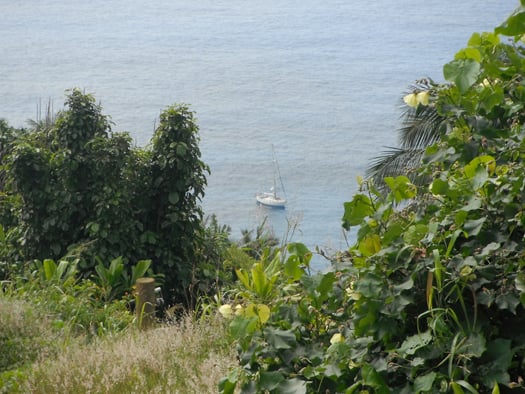
Restless anchorage. Suvretta in Bounty Bay on Pitcairn Island. Photo: Sam Davis
Eventually he fetched up for some time in Tonga, where he became enthused about the 73ft Vakas, the Pacific islanders' contemporary take on the classic Polynesian inter-island vessels (see Sailing on Saturday 11th January 2014). But by November 2012 it was time to head for home, so Suvretta sailed southeast for Cape Horn non-stop, and having rounded it, shaped her course for Port Stanley in the Falklands.
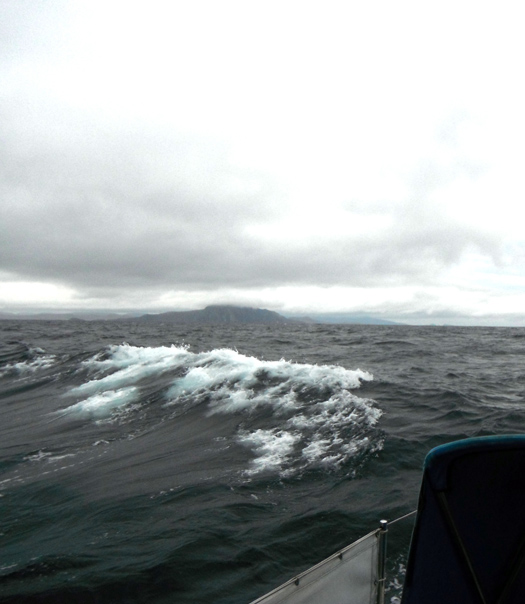
Suvretta rounding Cape Horn for the second time, 21st January 2013. It was only when the Horn was well astern that the weather deteriorated rapidly to make for a challenging approach to Port Stanley. Photo: Sam Davis
However, while rounding the Horn had been simple enough, the passage onwards to Stanley became increasingly fraught, running before rising storm force winds. Conditions were such that it looked for a while as though the lone sailor was going to be swept right past the islands, but he made the cut into shelter to such a nicety that he is awarded the ICC's Rockabill Trophy for Seamanship.
And then when Port Stanley was reached, a very fine passage had been completed from Tonga, so last night for that he was additionally awarded the ICC's Atlantic Trophy for the best voyage with a non-stop leg of more than a thousand miles. And then finally, after they'd spent the mid part of 2013 working their way up the Atlantic with the lone skipper particularly enjoying himself at ports on the Irish coast, Suvretta and Sam returned after three years to Conly Island. And they'd now done more than enough to also be awarded a third trophy - the ICC's premier honour, the Faulkner Cup.

Home again. Sam Davis back in Ireland, August 2013. Photo: W M Nixon
With such a high level of activity by many members, ICC adjudicators always find some final choices to be a very close call, so some years ago the Strangford Cup was inaugurated for the cruise which almost won the Faulkner Cup. This year it has gone to a fine cruise from Portugal to Madeira and through the Azores in detail before returning to Portugal.
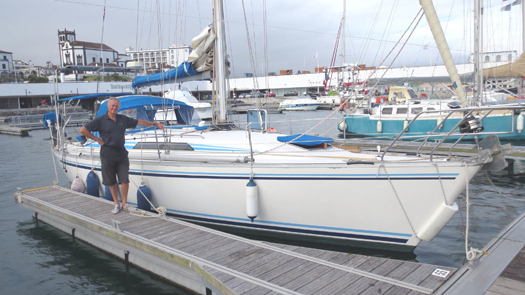
John Duggan with his MG CS40 Hecuba in Horta in the Azores
John Duggan originally hailed from Malahide where he sailed, and he also sailed with the college teams while at Trinity College in Dublin. He cruised and raced offshore mostly in the Irish Sea, but having qualified as an accountant he decided to spread his wings internationally, and he became one of those key people who turn up as partners in one of the big four accountancy firms worldwide.
Eventually his career brought him to the company's offices in Lisbon. Living in Portugal suited him fine, so he put down roots and in time bought himself an interesting cruiser. Hecuba is a 1989 Canadian-built Tony Castro-designed MG CS40, a handsome 12m craft with good performance enhanced by an effective wing keel.
During his final years in the day job he gradually improved the boat with a mind to some proper cruising once he retired at 60, something which he planned with all a high-powered accountant's meticulous attention to detail. He remembers the final day at the office, when a friend on the other side of the world sent him an email: "Even the worst day of your retirement will be better than the best day at work".

Azorean whaleboat with Pico beyond seen during one of Hecuba's cruises from Portugal to the Azores. Photo: John Duggan
Maybe so, yet not everyone makes the changeover smoothly, but in John Duggan's case the challenge of planning and executing remarkably civilised yet challenging cruises has proven to be a complete new job in itself, but much more fun than number crunching. He goes to enormous trouble to make sure that his crews have as enjoyable and varied an experience as possible, yet all the time he is quietly keeping the project moving along while noting details and features of ports visited which might be of interest to fellow skippers, a habit which is the hallmark of the true cruising man.
When you live in Cascais with your boat based in the marina nearby, the Azores are the western isles which call you each summer. But unlike Scotland's Western Isles which are just a day's sail away across the Sea of the Hebrides, the Azores involve an immediate ocean voyage from Portugal of at least 500 miles. However, for 2013's cruise west, Hecuba made it a triangle, going first to Madeira before going on nor'west to the Azores which were cruised in detail before returning to Cascais after six weeks away, having logged 2390 miles, with the final tabulation being:
Hours spent close hauled: Zero.
Cross words exchanged: Zero.
Inevitably the two big awards dominate the scoresheet, but the ICC also has a host of trophies which reflect every level of club sailing activity. The Round Ireland Cup, for instance, is for the circuit which produces most information for the club's sailing directions, and in a year in which a goodly number went round, it was Donal Walsh of Dungarvan with his Moody 31 Lady Kate who best filled the bill.

Donal Walsh's Lady Kate anchored at Inishmurray off the Sligo coast during his detailed round Ireland cruise. Photo: Donal Walsh
As the Faulkner Cup was first won in 1931 by the 28ft cutter Marie, the Marie Trophy is for the best cruise by a boat under 30ft, and Mick Delap from Valentia Island with his Tamarisk 24 gaff cutter North Star fits into the size requirement with six feet to spare. He made a fine job of completing a two-summer circuit of Ireland by returning from western Scotland via the Irish Sea and Ireland's south and southwest coasts.

Mick Delap's Tamarisk 24 North Star from Valentia in Lowlandman's Bay in Jura in the Hebrides. Photo: Mick Delap
In all, the ICC has a dozen cruising trophies. But even so not everyone gets one in a typically busy year, so to encourage the newcomers they've the Perry Greer Trophy for first time log-writers, and it goes to Peter Mullan from the Quoile in Strangford Lough for his insightful account of a round Ireland cruise with the Jeanneau Sun Odyssey Sancerre.
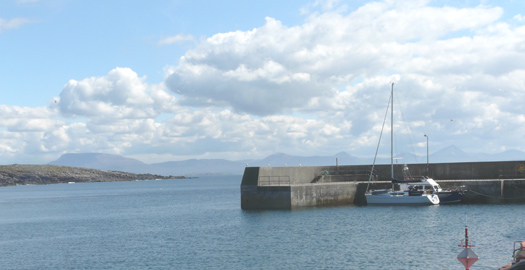
Peter Mullan's Sun Odyssey Sancerre in the little harbour at Tory Island with the Donegal highlands beyond. Photo: Peter Mullan
All the logs, including the winning ones, were featured in the ICC's 180-page Annual 2013, which Honorary Editor Ed Wheeler managed to get to the members in time for Christmas. All this is done by voluntary effort, yet the Annual would stand up to professional comparisons, as it includes informative accounts of cruises in just about every part of the world, plus a report on the ICC Cruise-in-Company to the Isles of Scilly which was an outstanding success despite coinciding with some uneven weather in June.
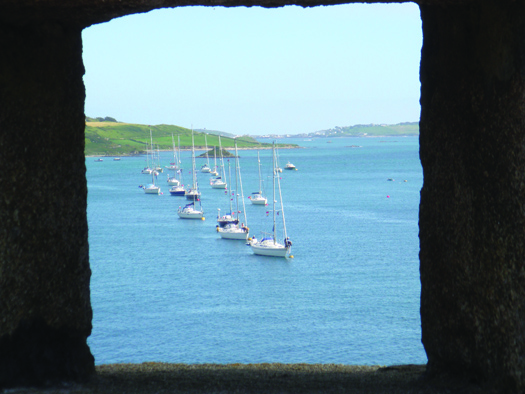
The Irish Cruising Club flotilla in the Isles of Scilly during their successful Cruise-in-Company in June 2013.

Everyone to his taste. ICC member Brian Black went to Greenland for the sixth time, crewing on Aurora. This is Kangertitiatsivaq Fjord in high summer. Photo: Brian Black
There's more to the Club than the Annual, as the ICC's programme of producing constantly up-dated Sailing Directions for the entire Irish coast in two volumes is a continuous progression, with the latest 12th Edition of the North & East Coast Book due next month from Honorary Editor Norman Kean, whose home port is Courtmacsherry.
Thus it's clear that Ireland's cruising club is a truly all-Ireland organisation, and this year it will be celebrating its 85th birthday with a Cruise-in-Company to Glengarriff where it was founded on July 13th 1929. Yet despite its obvious significance, this is a club without premises. In the final analysis, it's a club of the mind, made up of kindred spirits. Heading such a body is a mighty challenge, and the changing of the watch is always a charged moment.
Last night David Tucker of Kinsale stood down after serving his three years as Commodore, and he was succeeded by Peter Killen of Malahide. His experience in club administration is long-lived – he was Commodore of Malahide YC when it became "Club of the Year" in 1980. But it was his cruising CV which next went into overdrive, as in 1993 he voyaged north to Iceland, circled it, and then sailed back in near-record time in an S&S 30. He then moved up to a Sigma 36 which he cruised to Greenland among other places, following which he cruised even further with a Sweden 38, and then in 2004 he took on his dreamship, the Amel Maramu 54 Pure Magic.
Peter Killen seems to have cruised this very special boat just about everywhere. Not least was deep into Antarctica, where he made a memorable arrival in zero visibility with icy conditions into the natural harbour in the extinct volcanic crater on Deception Island. It was all a long way in time and distance from five boats gathered in Glengarrif in the hope of forming a little cruising organisation back in 1929. But that's the way it is with the Irish Cruising Club.
Russians Propose Tidal Power Dam For Strangford Lough
#PowerFromTheSea - Scenic Strangford Lough could be the site of an ambitious tidal power plant - if a proposal by a Russian energy firm comes to fruition.
The Belfast Telegraph reports on what it calls the "bizarre plan" to construct a dam across the lough that will link both sides by road and harness the strong tide to generate well over 1,000 gigawatt hours of green energy every year.
Martex Invest CEO Vladen Lunin is set to meet with Down District Council to outline his plans for the tidal barrage, similar to the Rance power station in Brittany.
And he hopes to sell councillors on the potential of the scheme to become a major tourist attraction for Northern Ireland.
Strangford Lough is known for having an exceptionally strong tidal current - and the Strangford Narrows are already home to Britain's first tidal power turbines, operated by SeaGen.
The Belfast Telegraph has more on the story HERE.
Portaferry Lifeboat Attends Converted Trawler After Power Failure
#RNLI - Portaferry RNLI responded to a mayday call about a converted fishing trawler at Ringhaddy Sound in Strangford Lough on Saturday night (24 August).
The alarm was raised by the crew of a nearby yacht who reported two men and two women on board an 80ft converted trawler, which had lost all power and was taking on water.
The Portaferry lifeboat crew launched before 8pm and were on the scene within 15 minutes. The sea at the time was calm with no wind and good visibility.
When the lifeboat arrived, one man and one woman had already transferred to the neighbouring yacht. The lifeboat crew then requested a salvage pump to help pump the water from the stricken boat.
A local vessel from Portaferry lent assistance by taking a pump to the lifeboat crew, and they met halfway between Portaferry and Ringhaddy.
With the assistance of the crew of the yacht who had called in the alert, the lifeboat manoeuvred the converted trawler onto the pontoons at Ringhaddy, and remained while the last of the water was pumped out and all four of its compliment were safely ashore.
Portaferry RNLI volunteer lifeboat operations manager Brian Bailie said: "We would like to pass on our thanks to everyone who helped bring this mayday call to a safe conclusion.
"The prompt actions of everyone involved resulted in a positive outcome and the volunteer RNLI crew for the second time in as many days helped to avert a potentially very serious situation."
Meanwhile, Donaghadee RNLI also launched on Saturday to go to the aid of a 17ft powerboat with four men on board that had run out of fuel off the Copeland Islands.
Belfast Coastguard received a call from the men shortly after 5pm and requested the lifeboat to launch.
The all-weather lifeboat crew, under second coxswain John Ashwood, located the vessel quickly and the decision was made to tow the casualty back to Donaghadee harbour. All returned safely shortly after 5.45pm.
Busy Weekend With Four Call-Outs For Portaferry RNLI
#RNLI - Portaferry RNLI in Co Down had a busy weekend with four separate call-outs over the two days.
The first came on Saturday 6 July following a report that three children were drifting offshore on an inflatable toy.
The volunteer lifeboat crew was already afloat on exercise as part of the annual raft race in Kircubbin, Co Down, when they got a call to go to the aid of the three children aged 10, 11 and 14 who were drifting out to sea on the inflatable 18 miles away at Cloughey Bay.
Thankfully by the time they arrived on scene a local coastguard unit had already attended and brought the three children to safety on shore.
Portaferry RNLI was called out for a second time at 4.10pm to rescue a number of people on board a speedboat that had lost power in Strangford Lough just off Killyleagh.
The crew arrived at the scene at 4.15pm, by which time the 15ft speedboat had already been towed in and was moored at the pontoons at Killyleagh Yacht Club in Strangford Lough.
On both occasions the weather was fine with good visibility and calm seas.
Yesterday (7 July) the volunteer crew launched for the third time to assist an injured woman on Salt Island in Strangford Lough.
The crew arrived at the island at 10.10am and assessed the situation before transporting two paramedics from Killyleagh to the injured woman, who was subsequently airlifted by Irish Coast Guard helicopter to Musgrave Park Hospital in Belfast for treatment.
At 11:35am, while returning to the lifeboat station, the crew was alerted once again, this time to go to the aid of two men onboard a five metre Dory that had lost power and was drifting just off Ringhaddy Sound in Strangford Lough.
The crew arrived on the scene at 12.05pm and took the men onboard the lifeboat, towing the powerless boat into Strangford Lough Yacht Club, where the men were then put ashore and their boat tied up.
Elsewhere in Northern Ireland, Newcastle RNLI assisted two men after their motor cruiser ran aground off the Co Down coast last Thursday (4 July).
The volunteer crew launched their inshore lifeboat at 2.20pm following a report from Belfast Coastguard that a small vessel had ran aground off Dundrum Bar with two people on board.
Weather conditions at the time were described as blowing south westerly four to five winds with moderate to choppy seas. There was good visibility.
The lifeboat, helmed by Nathan Leneghan and with crew members Declan Barry and Charles McClelland on board, arrived on scene at 2.30pm, where they observed that one of the men had made it to shore while the other was still on the 5m boat.
Speaking following the call-out, Newcastle RNLI deputy launching authority Joe McClelland said: "Thankfully, no one was in immediate danger and we were happy to bring the vessel and the man who was still on board safely to shore."
Portaferry RNLI Rescue Two Men In Drifting Dory
#RNLI - Portaferry RNLI launched on Saturday afternoon 15 June to go to the rescue of a small craft which had lost power in Strangford Lough, Co Down.
The volunteer lifeboat crew was alerted at 1.10pm following a call that there was a 5m Dory drifting after its engine had failed.
The lifeboat - helmed by Simon Rogers and with crew members George Toma, Brendan Byers and Ryan Kelly onboard - was launched at 1.20pm and was alongside the stricken vessel just off Gransha Point at 1.34pm.
The weather at the time was a slight swell, light winds and good visibility.
Once alongside, the lifeboat crew found that the Dory was taking on water. The two men were taken onboard the lifeboat and the Dory was towed into Strangford Lough Yacht Club where the men were also left off.

































